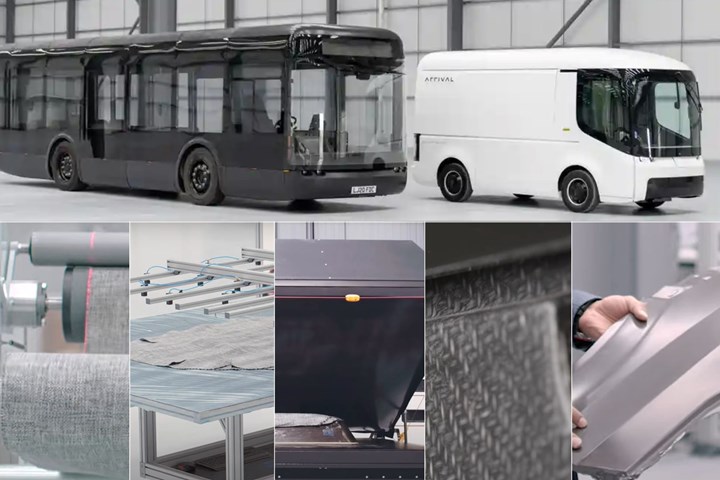Arrival EV producer becomes a Nasdaq-listed public company
Deliveries of composites-intensive EVs and expansion of global microfactory network set to ramp up, with first EVs due Q4 2021.

Photo credit: Arrival images compiled by CW
Global electric vehicle (EV) company Arrival (London, U.K.), became a publicly listed company March 25, trading on the Nasdaq Global Select Market with its Ordinary Shares and Warrants listed under the new ticker symbols “ARVL” and “ARVLW,” respectively. Arrival completed the previously announced special purpose acquisition company (SPAC) combination with CIIG Merger Corp. (New York, N.Y., U.S.) on March 24, 2021. The company plans to use its approximately $660 million in gross proceeds to ramp up delivery of its EVs and expand its global network of microfactories. Its first local facility in Rock Hill, S.C., U.S. is slated to begin producing the composite body panels for its EVs in Q4 2021.
“We believe that all vehicles will soon be electric, because it is better for people, the planet and business,” says Denis Sverdlov, founder and CEO of Arrival. “Arrival’s invention of a unique new method to design and produce vehicles using local microfactories makes it possible to build highly desirable yet affordable electric vehicles — designed for your city and made in your city. Going public is an opportunity that will allow us to continue to scale globally. We also understand that this comes with responsibility. Arrival has a remarkable company culture, which attracts great talent and enables us to be truly creative. The hard work of more than 1,800 people over the past six years has made this milestone possible, and I would like to personally thank each and every one of the team.”
Composite body panels
Due to the weight and cost of batteries and electric powertrains, explains Arrival chief of materials Rob Thompson, Arrival is using thermoplastic composites to make the body panels lighter and less expensive, in order to achieve cost parity with conventional diesel vehicles. The body panels start with fabrics which are laser cut, kitted and molded using automated manufacturing cells. This agile approach allows a smaller footprint in both space and cost versus traditional stamped steel bodies, which require billion dollar stamping, welding and paint lines. In contrast, Arrival uses in-mold coatings and its body panel tools cost tens of thousands instead of the millions of dollars required for stamped steel. Body panel waste can also be recycled and reused in new products.
New way to make vehicles
Arrival’s new method of designing and producing zero-emission vehicles is enabled by its in-house developed hardware, software and robotics technologies. This vertically-integrated approach uses low CapEx microfactories and enables Arrival to price its vehicles competitively with fossil fuel equivalents and provide customers with a lower Total Cost of Ownership (TCO). Arrival believes that by creating the best products and removing the price premiums that currently exist for EVs, it will help to accelerate the transition to clean-air and sustainable commercial vehicles.
Arrival’s microfactories are rapidly scalable and enable decentralized production that can be deployed in local communities, hiring local talent, paying local taxes and using the local supply chain. This hyper-local strategy also allows the production of vehicles designed for the local region’s mobility requirements, the company says.
Progess toward mass production
There has already been strong interest in its vehicles, says Arrival, with a commitment from United Parcel Service (UPS) to purchase up to 10,000 EVs plus an option for an additional 10,000.
Arrival’s Van is expected to begin public road trials with customers in summer 2021, and the Bus is expected to start trials in Q4 2021 with First Bus (Aberdeen, U.K.), reportedly one of the U.K.’s largest transport operators and leaders in sustainable mobility. Production for the Arrival Bus is expected to begin in Q4 2021 and the Arrival Van in the second half of 2022.
Arrival has grown to more than 1,800 employees located across the world including offices and engineering facilities in the U.S., U.K. and Germany. The company moved into its Bicester, U.K. factory last May, will open its North American headquarters later this year in Charlotte, North Carolina, and has also a new microfactory in Charlotte to fulfill the UPS vehicle order.
Arrival also recently announced its global Board of Directors, bringing diverse expertise with backgrounds at Marvel, Hyundai Motor Co., Hearst, Lyft and Netflix.
Related Content
“Structured air” TPS safeguards composite structures
Powered by an 85% air/15% pure polyimide aerogel, Blueshift’s novel material system protects structures during transient thermal events from -200°C to beyond 2400°C for rockets, battery boxes and more.
Read MoreCo-molding SMC with braided glass fiber demonstrates truck bed potential
Prepreg co-molding compound by IDI Composites International and A&P Technology enables new geometries and levels of strength and resiliency for automotive, mobility.
Read MoreInfinite Composites: Type V tanks for space, hydrogen, automotive and more
After a decade of proving its linerless, weight-saving composite tanks with NASA and more than 30 aerospace companies, this CryoSphere pioneer is scaling for growth in commercial space and sustainable transportation on Earth.
Read MoreComposites end markets: Automotive (2024)
Recent trends in automotive composites include new materials and developments for battery electric vehicles, hydrogen fuel cell technologies, and recycled and bio-based materials.
Read MoreRead Next
Plant tour: Daher Shap’in TechCenter and composites production plant, Saint-Aignan-de-Grandlieu, France
Co-located R&D and production advance OOA thermosets, thermoplastics, welding, recycling and digital technologies for faster processing and certification of lighter, more sustainable composites.
Read MoreVIDEO: High-volume processing for fiberglass components
Cannon Ergos, a company specializing in high-ton presses and equipment for composites fabrication and plastics processing, displayed automotive and industrial components at CAMX 2024.
Read MoreAll-recycled, needle-punched nonwoven CFRP slashes carbon footprint of Formula 2 seat
Dallara and Tenowo collaborate to produce a race-ready Formula 2 seat using recycled carbon fiber, reducing CO2 emissions by 97.5% compared to virgin materials.
Read More


























